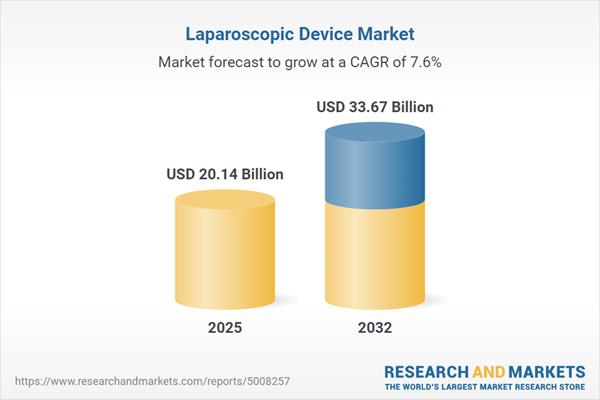Speak directly to the analyst to clarify any post sales queries you may have.
Senior healthcare leaders in procurement and strategy are steering their organizations through a rapidly evolving laparoscopic device market, where innovation, compliance, and operational efficiency have a direct impact on patient care and institutional growth.
Market Snapshot: Laparoscopic Device Market Size and Growth
The global laparoscopic device market reached USD 18.69 billion in 2024 and is projected to rise to USD 20.14 billion by 2025 and USD 33.67 billion by 2032. Expansion is driven largely by greater adoption of minimally invasive technologies within hospital and clinical settings. Leadership teams are using these technologies to enhance patient outcomes, improve perioperative operations, and stay ahead of changing regulatory requirements. Progress in clinical methods and instrument advancements are fostering continued market momentum. Organizations that invest in integrating modern laparoscopic systems position themselves to adapt in a competitive environment and build strengthened clinical programs.
Laparoscopic Device Market Scope & Segmentation
Comprehensive insight into laparoscopic device market segmentation enables healthcare executives to guide sustainable strategies and manage risks effectively. Key segments reflect ongoing shifts in demand, use cases, and supplier innovation:
- Product Categories: Access devices such as bladed or bladeless trocars, diverse energy-based systems, and advanced surgical instruments including dissecting and grasping tools, retraction equipment, scissors, along with CO2 insufflation solutions, specimen retrieval products, and integrated visualization platforms with cameras and monitors.
- Application Areas: Used across general, bariatric, cardiothoracic, colorectal, gynecological, and urological surgeries, these devices respond to the expanding call for minimally invasive procedures across multiple clinical specialties.
- End User Settings: Adoption trends vary among hospitals, ambulatory surgery centers, and specialized clinics, each presenting different operational, procurement, and workflow integration priorities.
- Usage Models: Both disposable and reusable configurations are supporting infection prevention, resource stewardship, and environmental sustainability within surgical workflows.
- Geographic Regions: Market growth is anchored by North America, Europe, Asia-Pacific, Latin America, the Middle East, and Africa, with particularly rapid healthcare infrastructure expansion in China, India, and Southeast Asia spurring further opportunity and diversification.
- Leading Companies: Johnson & Johnson, Medtronic plc, Stryker Corporation, Olympus Corporation, Intuitive Surgical, B. Braun Melsungen AG, KARL STORZ SE & Co. KG, CONMED Corporation, Boston Scientific Corporation, and Richard Wolf GmbH each drive supply dependability and ongoing product innovation throughout the value chain.
Key Takeaways for Senior Decision-Makers
- Integrating robotic platforms and high-definition digital imaging into surgical procedures allows clinical teams to improve precision and optimize workflow outcomes.
- Flexible device development centered on infection control enables compliance with patient safety objectives and regulatory expectations across varied care settings.
- Investments in monitoring and operational quality enforce institutional readiness, supporting swift adaptation to shifting compliance and care delivery requirements.
- Strategic sourcing, including multi-vendor collaborations and expanded supplier networks, reduces exposure to potential supply chain interruptions and offers access to evolving surgical technologies.
- Active engagement with technology suppliers supports fast implementation cycles, ensuring seamless responses to updated clinical standards and innovations across device portfolios.
- Developing supplier relationships across diverse geographic markets provides both stability and agility as global regulations fluctuate and regional opportunities grow.
Tariff Impact: Navigating U.S. Trade Policy Shifts
Recent changes in U.S. tariffs affecting surgical equipment are prompting a shift in sourcing strategies for hospitals and surgical facilities. Senior executives are increasingly weighing domestic and nearshore suppliers to decrease costs and provide resilience against policy changes and potential supply chain challenges.
Methodology & Data Sources
This report’s methodology combines extensive secondary research, direct expert input from practicing surgeons and purchasing teams, and scenario-based quantitative modeling. Data triangulation ensures the resource is both reliable and actionable for leaders working within the laparoscopic device market.
Laparoscopic Device Market: Why This Report Matters
- Delivers a clear executive framework tailored to adapting procurement, clinical, and compliance strategies amid change.
- Informs business planning that balances evolving regulatory priorities and operational resource demands while enhancing resilience to disruption.
- Equips decision-makers with pragmatic guidance to optimize resource allocation and identify new opportunities in the minimally invasive surgery sector.
Conclusion
This report gives senior healthcare leaders the clarity and strategic direction needed to thrive within a dynamic laparoscopic device market. By leveraging actionable insights, organizations can secure operational success as industry technology and regulations continue to advance.
Additional Product Information:
- Purchase of this report includes 1 year online access with quarterly updates.
- This report can be updated on request. Please contact our Customer Experience team using the Ask a Question widget on our website.
Table of Contents
3. Executive Summary
4. Market Overview
7. Cumulative Impact of Artificial Intelligence 2025
Companies Mentioned
The companies profiled in this Laparoscopic Device market report include:- Johnson & Johnson
- Medtronic plc
- Stryker Corporation
- Olympus Corporation
- Intuitive Surgical, Inc.
- B. Braun Melsungen AG
- KARL STORZ SE & Co. KG
- CONMED Corporation
- Boston Scientific Corporation
- Richard Wolf GmbH
Table Information
| Report Attribute | Details |
|---|---|
| No. of Pages | 193 |
| Published | October 2025 |
| Forecast Period | 2025 - 2032 |
| Estimated Market Value ( USD | $ 20.14 Billion |
| Forecasted Market Value ( USD | $ 33.67 Billion |
| Compound Annual Growth Rate | 7.6% |
| Regions Covered | Global |
| No. of Companies Mentioned | 11 |









